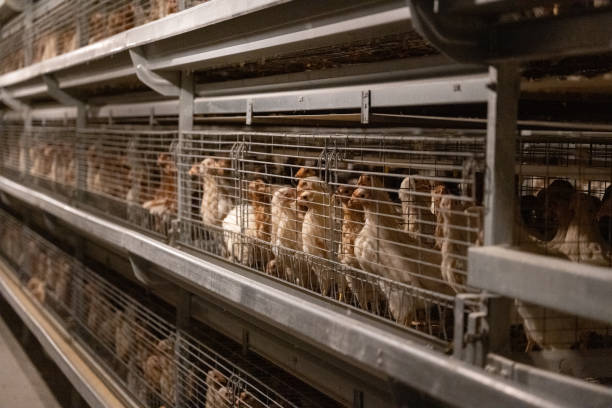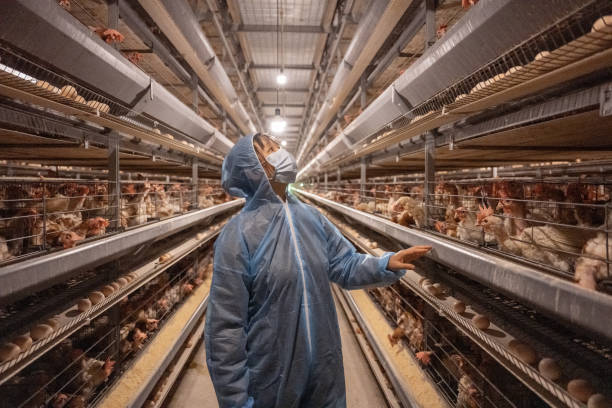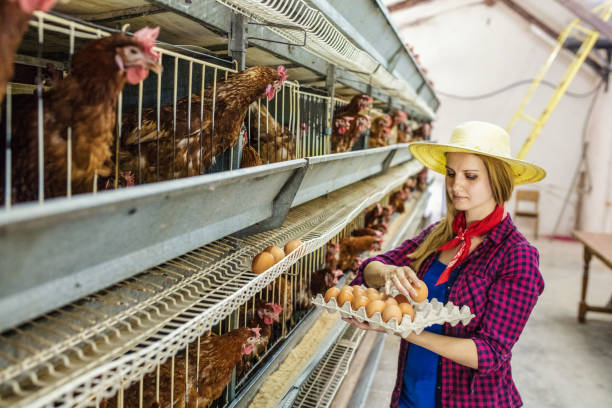Full Automatic Layer Cages: Maximizing Egg Production in Tanzania
Full Automatic Layer Cages: Maximizing Egg Production in Tanzania

Tanzania’s poultry industry is on the rise, fueled by increasing demand for eggs driven by a growing population and a shift towards more protein-rich diets. However, traditional farming methods often struggle to meet this demand efficiently. That’s where full automatic layer cages come into play, offering a transformative solution for maximizing egg production and streamlining poultry farming operations across Tanzania. This article will delve into the intricate details of full automatic layer cages, exploring their benefits, components, implementation, and long-term impact on the Tanzanian poultry sector.
What are Full Automatic Layer Cages?
Full automatic layer cages represent a significant leap forward in poultry farming technology. Unlike conventional cage systems that rely heavily on manual labor, these cages automate key processes such as feeding, watering, egg collection, and manure removal. This automation not only reduces labor costs but also improves biosecurity, enhances bird welfare, and most importantly, significantly boosts egg production.
Benefits of Adopting Full Automatic Layer Cages in Tanzania
The advantages of transitioning to full automatic layer cages are numerous and far-reaching for Tanzanian poultry farmers:
Increased Egg Production: Automation ensures consistent feeding and watering schedules, optimizing the hens’ nutrient intake. This leads to improved egg-laying performance and higher egg output per hen. Controlled environmental conditions within the cages, such as temperature and ventilation, also minimize stress on the birds, further contributing to increased egg production.
Reduced Labor Costs: Tanzania, like many African nations, faces labor challenges, particularly in rural areas. Full automatic layer cages dramatically reduce the need for manual labor, freeing up farmers to focus on other critical aspects of farm management such as marketing, financial planning, and overall flock health. The savings on labor costs translate to increased profitability and competitiveness.

Improved Biosecurity: The enclosed environment of full automatic layer cages minimizes the birds’ contact with external pathogens and reduces the risk of disease outbreaks. Automated manure removal systems further contribute to a cleaner and more hygienic environment, reducing the spread of bacteria and parasites. This improves the overall health of the flock and minimizes the need for costly veterinary interventions.
Enhanced Bird Welfare: While cage systems have sometimes faced criticism regarding bird welfare, modern full automatic layer cages are designed with the hens’ well-being in mind. The cages provide ample space for movement, perching, and nesting behavior. Proper ventilation, lighting, and temperature control create a more comfortable and stress-free environment for the birds. Automatic feeding and watering systems also ensure that all hens have access to adequate nutrition and hydration.
Optimized Space Utilization: Full automatic layer cages allow for a higher stocking density compared to traditional floor-based systems. This means that farmers can raise more birds in the same amount of space, maximizing their land utilization and overall productivity. This is particularly advantageous in areas where land is scarce or expensive.
Data-Driven Management: Many modern full automatic layer cage systems incorporate advanced sensor technology and data analytics. These systems monitor key parameters such as temperature, humidity, feed consumption, water intake, and egg production. This data allows farmers to identify potential problems early on, optimize their management practices, and make informed decisions to improve overall farm performance.
Components of a Full Automatic Layer Cage System
A complete full automatic layer cage system typically comprises several key components working in synergy to deliver optimal performance:
Cage Structure: The cages themselves are typically constructed from galvanized steel wire mesh, providing durability and strength. They are designed to provide adequate space, ventilation, and access to feed and water for the hens. The cages are often arranged in tiers to maximize space utilization.
Automatic Feeding System: This system distributes feed evenly to all cages at predetermined intervals. It typically consists of a feed hopper, a conveyor belt or chain, and a dispensing mechanism that delivers feed to the hens’ feeders. The system can be programmed to adjust the feed quantity based on the hens’ age and production stage.
Automatic Watering System: This system provides a constant supply of fresh, clean water to the hens. Nipple drinkers are commonly used, as they minimize water wastage and prevent contamination. The system can be adjusted to regulate water pressure and flow rate.
Automatic Egg Collection System: This system collects eggs from the cages and transports them to a central collection point. It typically consists of an egg conveyor belt that runs along the length of the cages and a mechanism that gently lifts the eggs onto the belt. This system reduces egg breakage and minimizes the need for manual handling.
Automatic Manure Removal System: This system removes manure from the cages regularly, preventing the buildup of ammonia and other harmful gases. Several types of manure removal systems are available, including scraper systems, belt systems, and flushing systems. The choice of system depends on the farmer’s specific needs and preferences.
Environmental Control System: This system maintains optimal temperature, humidity, and ventilation levels within the poultry house. It typically consists of fans, heaters, cooling pads, and a control panel that regulates these components based on pre-set parameters. Proper environmental control is essential for maintaining the hens’ health and productivity.
Control System: The control system acts as the brain of the entire operation, orchestrating all the automated functions based on pre-programmed settings and real-time data input. This system allows farmers to monitor and manage their flock remotely, ensuring optimal conditions and addressing any potential issues promptly.
Implementing Full Automatic Layer Cages in Tanzania
The successful implementation of full automatic layer cages requires careful planning and execution:

Site Selection and Preparation: Choose a suitable location for the poultry house, considering factors such as access to water and electricity, proximity to markets, and environmental regulations. Prepare the site by leveling the ground, constructing a concrete foundation, and ensuring proper drainage.
Poultry House Construction: Constructing a well-insulated and properly ventilated poultry house is critical for maintaining optimal environmental conditions. The house should be designed to accommodate the chosen cage system and allow for easy access for maintenance and cleaning.
Cage System Installation: Install the cage system according to the manufacturer’s instructions. Ensure that all components are properly connected and functioning correctly. It’s crucial to work with experienced technicians during the installation process to avoid any errors.
Stocking and Management: Purchase healthy pullets (young hens) from a reputable hatchery. Gradually introduce the pullets to the cage system and provide them with appropriate feed and water. Monitor their health and behavior closely, and adjust management practices as needed.
Training and Support: Provide adequate training to farm workers on the operation and maintenance of the full automatic layer cage system. Establish a relationship with a reliable supplier who can provide ongoing technical support and spare parts.
Long-Term Impact on the Tanzanian Poultry Sector
The adoption of full automatic layer cages has the potential to transform the Tanzanian poultry sector, contributing to food security, economic growth, and improved livelihoods:
Increased Egg Availability: By maximizing egg production, full automatic layer cages can help meet the increasing demand for eggs in Tanzania and reduce the country’s reliance on imports. This will contribute to food security and improved nutrition for the population.
Job Creation: While automation reduces the need for manual labor, it also creates new job opportunities in related industries such as cage manufacturing, installation, maintenance, and technical support. This contributes to economic diversification and job creation in Tanzania.
Improved Farmer Incomes: By increasing egg production and reducing labor costs, full automatic layer cages can significantly improve the profitability of poultry farming. This will lead to higher incomes for farmers and improved livelihoods for their families.
Enhanced Competitiveness: The adoption of full automatic layer cages will make Tanzanian poultry farmers more competitive in the regional and international markets. This will boost exports and contribute to the country’s economic growth.
Sustainable Poultry Farming: Full automatic layer cages contribute to sustainable poultry farming by optimizing resource utilization, reducing waste, and minimizing environmental impact. This will help ensure the long-term viability of the poultry sector in Tanzania.
Overcoming Challenges and Ensuring Success
While the benefits of full automatic layer cages are undeniable, successful implementation requires addressing potential challenges:
Initial Investment Costs: Full automatic layer cages require a significant upfront investment, which may be a barrier for some small-scale farmers in Tanzania. Government subsidies, access to affordable financing, and cooperative farming arrangements can help overcome this challenge.
Technical Expertise: Operating and maintaining full automatic layer cages requires technical expertise. Training programs, technical support from suppliers, and collaboration with agricultural extension officers can help farmers develop the necessary skills.
Reliable Power Supply: Full automatic layer cages rely heavily on electricity. In areas with unreliable power supply, it is essential to invest in backup generators or alternative energy sources such as solar power.
Market Access: Farmers need access to reliable markets to sell their eggs. Developing strong marketing channels, establishing relationships with wholesalers and retailers, and promoting egg consumption can help ensure market access.
Conclusion
Full automatic layer cages represent a game-changing technology for the Tanzanian poultry sector. By maximizing egg production, reducing labor costs, improving biosecurity, and enhancing bird welfare, these systems offer a pathway to a more efficient, profitable, and sustainable poultry industry. While challenges exist, the potential benefits are immense. With strategic investments, training initiatives, and supportive government policies, Tanzania can unlock the full potential of full automatic layer cages and transform its poultry sector into a thriving engine of economic growth and food security. The future of egg production in Tanzania is undoubtedly intertwined with the adoption and successful implementation of this transformative technology.





